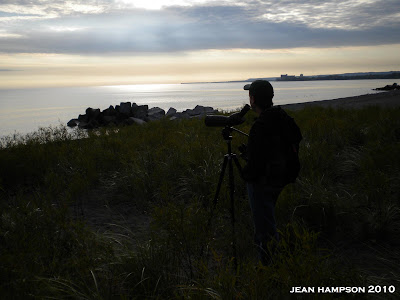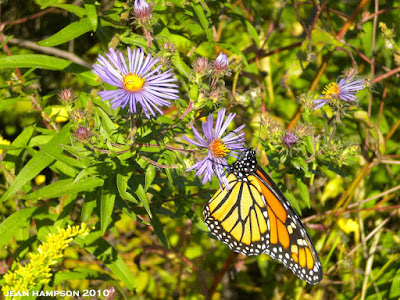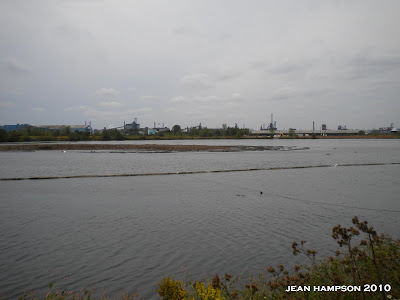It's September and jaegers are once again appearing at the west end of Lake Ontario before continuing their journey from the Arctic to winter on the ocean. We observed our lifer Parasitic Jaeger at Van Wagners Beach during an OFO trip in October of 2009. On Saturday September 18, we went hunting for a Long-tailed Jaeger.
 A beautiful morning at Van Wagners Beach.
A beautiful morning at Van Wagners Beach.Arriving at the beach, I chose a spot for the scope and preceded to wait. From what I have read, it can be a waiting game when looking for jaegers. Though the wind was not favourable for spotting the large seabirds, the weather could not have been better. Canada Geese and Ring-billed Gulls were present along the shoreline while two Downy Woodpeckers continuously called from the nearby trees. Long lines of Double-crested Cormorants were on the move but that was it for flybys. Time for a change of pace. We strolled along the bike path and crossed the road to look for passerine migrants at the nearby ponds.
As soon as she looked into the tall Willows, Jean spotted a male Wilson's Warbler. I failed to find it as it moved quickly from tree to tree but I did get to see a female in the same area. The birds were fast and furious. Other species found included Northern Parula, Magnolia Warbler, Rose-breasted Grosbeak, and Scarlet Tanager. Walking south, we entered the natural regeneration area where I was treated to a great look at a male Wilson's Warbler. In a small apple tree, we observed a dull coloured bird with faint streaking on the sides of the breast and yellow undertail coverts. Orange-crowned Warbler! Jean and I have not seen this species since October of 2007. This was a much needed tick if we are to reach 200 species this year. Before reaching the abandoned railway bed, we observed Great Crested and Least Flycatcher, Cedar Waxwing, Hermit Thrush and Yellow-bellied Sapsucker. Walking along the railway line, Common Yellowthroat flitted in the bushes. Wading birds observed in the ponds included Great Egret, Black-crowned Night-Heron (juvenile) and Great Blue Heron.


Every where we go, we encounter Monarch Butterflies.

The pedestrian bridge is progressing nicely. It won't be long before we are able to walk over to the Windermere Basin from Van Wagners Road.

Our birding completed at the ponds, Jean and I returned to Van Wagners Beach for a break and another session of waiting for a jaeger flyby. Within seconds of sitting down, the bird we were waiting for flew by, heading south along the shoreline. There was no doubt. This was the Long-tailed Jaeger. Our 300th lifer! It rested on the water for a short period of time before continuing on in a southerly direction towards a large group of gulls. For approximately an hour we stood on the beach and observed the jaeger 3 more times as it flew back and forth over the water. During one of its passes, we watched the jaeger fly in a downward spiral as it chased after a gull. Harassment is their speciality. Last year's lifer Parasitic Jaeger was seen chasing a Double-crested Cormorant. After the jaeger show and a plate of celebratory fries at Hutch's Restaurant, we headed over to the Windermere Basin to check out the waterfowl and shorebirds.

OK. Not one the most esthetically pleasing views but some great birds have been recorded at this location. During the winter months, the Basin does not freeze and attracts large flocks of waterfowl. This late summer day, only Canada Goose and Mute Swan were observed with a few Double-crested Cormorants and a couple of Pied-billed Grebes. Looking towards the southernmost section of the Basin from where we stood, Jean and I could see Greater and Lesser Yellowlegs but even with the use of our scope, smaller shorebirds were difficult to identify. We decided to walk along the gravel path to find an accessible location that would give us a closer look at the shorebirds feeding in the mud. We met a birder leaving the area and he let us know what birds he found and where we could stand to view them. Many thanks to him.

Jean and I could now identify the unknown shorebirds and added White-rumped Sandpiper (1) and Ruddy Duck (9) to the year list.

It turned out to be a great day of birding. As it has been for many Ontario birders, the Long-tailed Jaeger was surprisingly cooperative for Jean and I. Only a short period of time was required to observe the migrating seabird, allowing us to add an additional 4 species to the year list when birding the ponds and the Windermere Basin. Reaching 200 by the end of the year is possible. With only 13 to go, time will tell. Did the OFO Annual Convention at Long Point over the last weekend in September prove to be a worthy investment? Migration is in full swing and birding the Long Point area just might have been the right choice for this Niagara birder to get 200 birds this year.








No comments:
Post a Comment